| کد مقاله | کد نشریه | سال انتشار | مقاله انگلیسی | نسخه تمام متن |
|---|---|---|---|---|
| 6084297 | 1206049 | 2012 | 8 صفحه PDF | دانلود رایگان |

ObjectiveTo compare the cervical status after neck sprains in frontal and rear-end car impacts with respect to earlier proposed neck-sprain injury mechanisms, rotated head at impact, and the seat-belt geometry.MethodsA prospective, multidisciplinary, in-depth study was made based on 23 car occupants injured in frontal impacts and 108 injured in rear-end impacts. The active neck mobility was measured in protraction-retraction, flexion-extension, side bending right-left, and rotation right-left. This was done in the acute phase and then three and twelve months later. The maximum range, increase in pain, and level of pain were recorded for each movement. A subgroup with increased pain during movements towards the impact direction, but not in the opposite one, so-called isolated contra-directional pain (ICP), was further analysed. The side bending and rotation mobility were studied in another subgroup, in which the head was rotated inwards or outwards relative the car, i.e. away from or towards the diagonal part of the seat belt.ResultsRear-end impacts more often than frontal impacts caused greater restrictions of the cervical mobility and more frequently increased pain at the three different times that measurements were recorded, but, with few exceptions, the differences for each movement were not statistically significant. Increased pain during extension was more often noted after rear-end impacts. ICP during pro-/retraction was also more often noted after rear-end impacts. Head-inward rotation in rear-end impacts caused a more restricted mobility in the same direction at the primary examination than head-outward rotation.ConclusionsThe cervical status after neck sprains in frontal and rear-end car impacts is very similar, and the cervical range of movement in different directions and increased pain during cervical motions do not reveal any specific isolated injury mechanisms. Combined injury mechanisms should be considered, and further studies are recommended to investigate asymmetric loading during impact.
⺠The cervical status after neck sprain in frontal and rear-end impacts was compared. ⺠The differences were small, but rear-end impacts influenced status somewhat more. ⺠The findings did not disclose any specific isolated injury mechanism. ⺠Further studies should consider combined injury mechanisms. ⺠Injury mechanisms during asymmetric loads should be further investigated.
Journal: Injury - Volume 43, Issue 4, April 2012, Pages 423-430